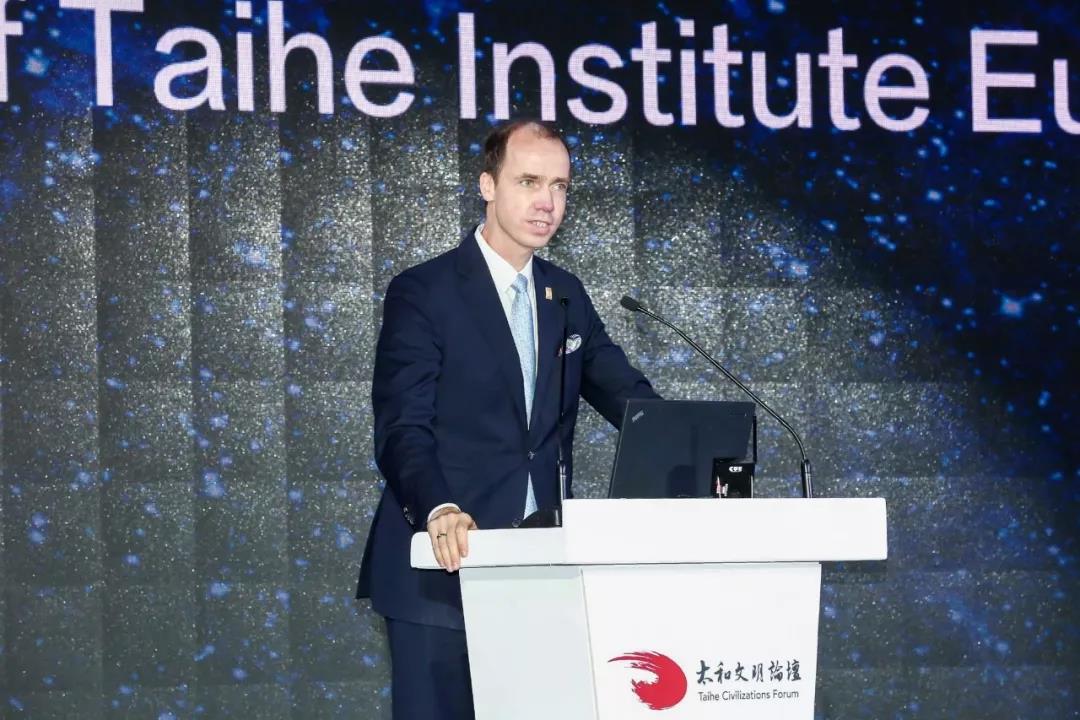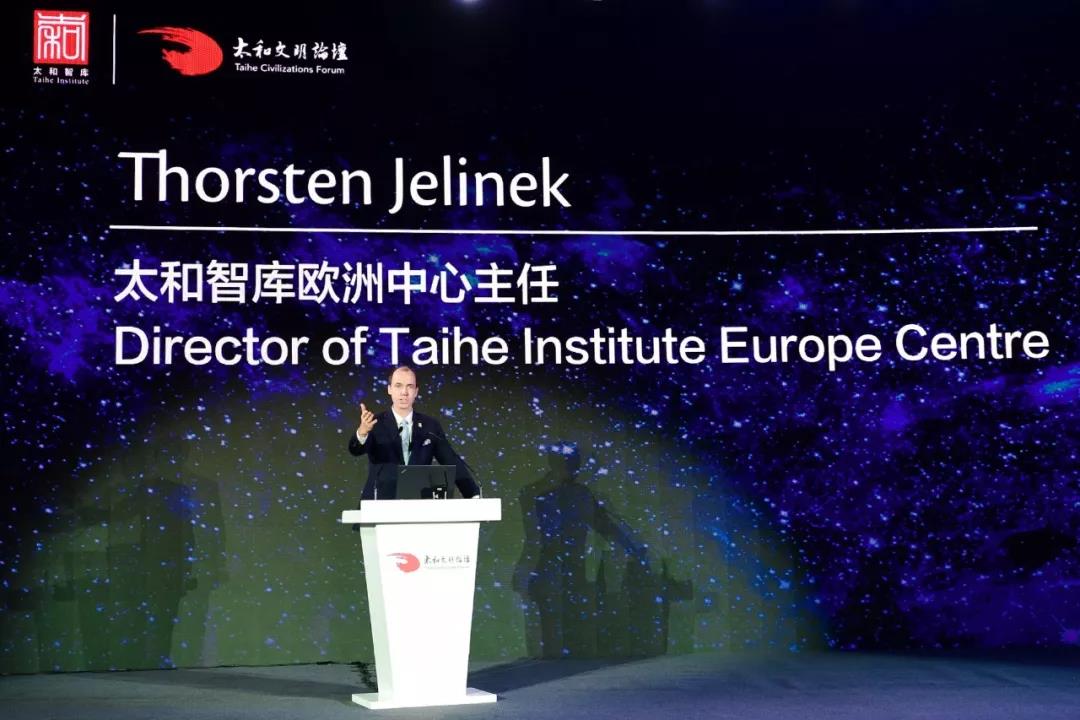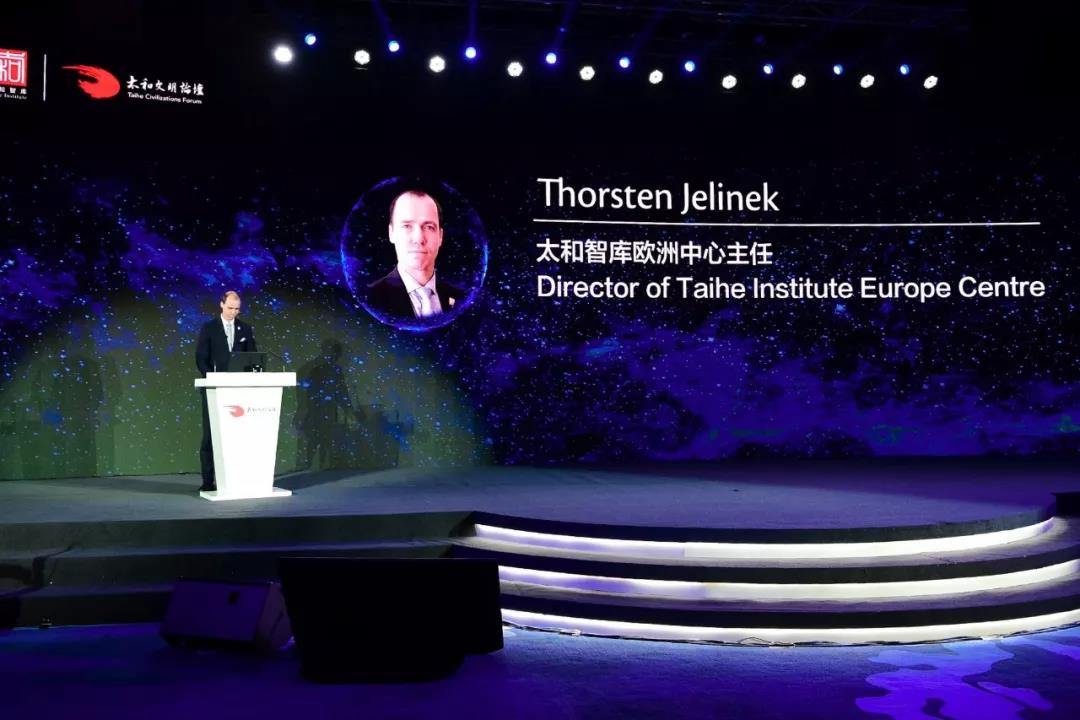Summary : Despite increased climate actions in recent years, greenhouse gas emissions have reached an all-time high. Without overcoming psychological and structural inertia, human-kind will stay on a collision course with the natural world. Confronting a problem that threatens the end of human civilization means fundamentally rethinking how our modern civilization functions today. A new set of common values and global stewardship are needed to achieve more impactful and necessary change. This opinion piece was part of the opening speech given by Thorsten Jelinek at the 2018 Taihe Civilization Forum on 7th September in Beijing.

Director of Taihe Insititute Europe Centre Thorsten Jelinek
Climate inaction and structural inertia keeping us on a failing trajectory
The 2015 Paris Agreement was an historical moment: almost all member states set aside their differences and agreed that collective action was urgently needed to prevent earth from reaching 2 °C above the temperature of preindustrial times. Almost all parties turned into a community of shared purpose and destiny. Only a few years later, however, this moment of celebration has clearly faded, international consensus become a rare occasion, and climate reality caught up with the previous optimism.
This year, 2018, is likely to become another peak year. It will surpass the five hottest summers on record, which all occurred in the past 10 years. This year has witnessed an unusual amount and intensity of heatwaves, droughts, forest fires, and flooding. High temperatures have become 100 times more likely than 50 years ago. According to objective scientists, global temperatures will unlikely stay below the 2 °C target and climate change will unlikely stay a distant threat.
The 2 °C threshold might be an arbitrary target, but the warmer the atmosphere gets, the more often and more intensely climate-related hazards and natural disasters will occur, destroying infrastructure, displacing thousands and millions of people, and further exacerbating poverty. The environmental, economic, and human cost will be immense and have a greater influence than any other forces in the world today. Global warming will lead to unpredictable consequences towards flora, fauna, and ultimately us human beings. Even though human-made CO2 emissions could be lowered over the next decades, not just the “greenhouse effect,” but then the “hothouse effect” will continue increasing CO2 levels and temperatures, as natural carbon storages — such as oceans, permafrost soils, and forests — will begin releasing their own stored CO2.
The devastating impact of the climate crisis should come as no surprise. We are consuming more natural resources than Earth can reproduce each year. In 2017, we consumed 1.7 earths to produce enough natural resources to match global consumption for that year. In 1987, the “Earth Overshoot Day” occurred in December; in 2017, it was already reached in August. In addition to other forms of resource over-exploitation and pollution, we are emitting more carbon dioxide into the atmosphere than the natural ecosystems can absorb.
Highlighting such staggering development is not about pessimism over optimism. Climate change and sustainable development require actions, which are more impactful and better coordinated globally. A new form of global leadership and stewardship is needed. No doubt, there have been a lot of climate change-related actions in the past, and there has been an increase in actions since the Paris Agreement. Governments, businesses, and civil societies around the globe have increased pledging their commitments to climate action and divesting from fossil fuels. Some good results can be seen: On 1st January 2018, for the first time, Germany’s power generation was entirely based on renewable energy on that day. Britain is about to phase out coal-based power altogether this year. Although the current administration of the United States has withdrawn from the Paris Agreement, we can see progress and climate actions at the U.S. state and city levels. India has also committed billions of dollars to becoming a renewable energy superpower by 2030.

One country that has made tremendous progress is China. China has emerged as the leader in sustainable development and clean energy. It has invested more in renewable energy than any other country in recent years. The Ministry of Ecology and Environment has been further empowered to carried out necessary regulations, which was previously controlled by the National Development & Reform Commission. China’s domestic reforms on clean energy and sustainable development are driven by sever levels of water, air, and soil pollution and degradation, as well as the immediate and future impact of climate change and resource scarcities. China might be leading in climate action but hasn’t actively sought for global leadership because of its own tremendous challenges.
As China is expected to surpass the United States as the largest global economy within a few years from now, China will continue growing and developing, which means more resource exploitation, more emissions, more waste, and more pollution. The Chinese government has realized, however, that the next phases of urbanization and industrialization cannot follow the rapid development pattern of the past forty years. China itself is strongly exposed to the impact of climate change. In the South, China’s large coastal cities are vulnerable to flooding. In the North, entire regions are running out of water and could become target of severe heatwaves affecting millions of people.
Despite all climate actions in the past, nevertheless, carbon dioxide emissions have still reached an all-time high, and are projected to continue rising over the next decades. The concentration of CO2 exceeds 410 parts per million, which is the highest level ever since. Despite the progress made in areas such as circular economy, renewable energy, electrification, smart cities, or climate finance and carbon pricing, most economies remain locked in unsustainable patterns of power generation, industrial production, processing, and consumption. While renewable energy has been on the rise, so has the global demand for coal.

We are on a collision course with the natural world, and soon, if not already, it will be too late to shift the course from our failing trajectory. This threatening development leaves us with one sincere question: How could climate change get this far, or why are we not capable of making climate action truly effective? There are at least two intertwined explanations.
Firstly, climate change is such a vast and complex issue that it lacks any historical references to past experiences. Climate change defeats our traditional thinking. Either we cannot, or we simply don’t want to comprehend such “hyper-object”. It starts to paralyze individuals psychologically and the psychology of entire societies. We have already accepted living in the Anthropocene age. We have accepted climate change as a reality, but one that is perceived as being external to us and therefore as one that cannot be changed. However, climate change is not just a fact, but also human-made and repeated through our very collective behavior. Climate change also appears external to us, as this climate crisis still impacts only a fraction of the global population. Still, for most of us it is a distant threat. As a consequence, culturally, we rather engage in “climate fiction,” which has already become a cultural genre. We can easily imagine the end of civilization and a few privileged people colonizing a distant planet, as opposed to working harder on real issues, such as climate mitigation and resilience strategies. As a result of such psychological paralysis, climate change is less about “climate denial,” but more about “climate inaction.” People easily cling to power and identity, rather than to knowledge and facts. Even if we come across innovative ideas, they do not permeate into the mainstream.
Hence, the second fundamental reason underlying the current impasse on climate action is a deeply-seated structural inertia that is maintained through national, political, and economic interests. This structure has created lots of wealth, but this structure has also been developed based on the excessive use of fossil fuels, and nothing is more tied to energy use than economic activity. Energy constitutes much of what we desire today and continues repeating our linear economy of “take-make-consume-and-dispose.” Arguably, this system has also caused the current global development, which is based on slow or volatile growth, rising inequality, mass-migration, protectionism, populism, and rising geopolitical tension. Those dynamics only further perpetuate the structural inertia and draw the attention away from the utmost importance of climate action and sustainable development.
Confronting a problem that threatens the end of human civilization means fundamentally rethinking how our modern civilization functions today. To decouple economic development from fossil fuels, environmental pollution, and waste generation, means to alter the mode of development and the very fabrics of modern civilization itself. This requires both, technologies and concepts that enable a rapid transition to a carbon-free society, and common values that inform political action and build acceptance within society. We urgently need to build and spread those bridges of common ideas and actions before it is too late.
-

- China-US trade war not yet at climax 18 September , 2018
-

- Comparing SCO to NATO inappropriate 16 September , 2018
-

- Sustainability and climate action: overcoming psychological ... 11 October , 2018
-

- 2018 Taihe Civilizations Forum Content Highlights 15 April , 2019
-
2018 Content Highlights
-

- Rashid Alimov Secretary-General of the Shanghai Cooperation Organization(2016-2018).
-

- Mohamed Sameh Amr Professor of International Law Department at Cairo University. He is also a ...
-

- Irina Bokova Distinguished Fellow of Taihe Institute, Director-General of...
